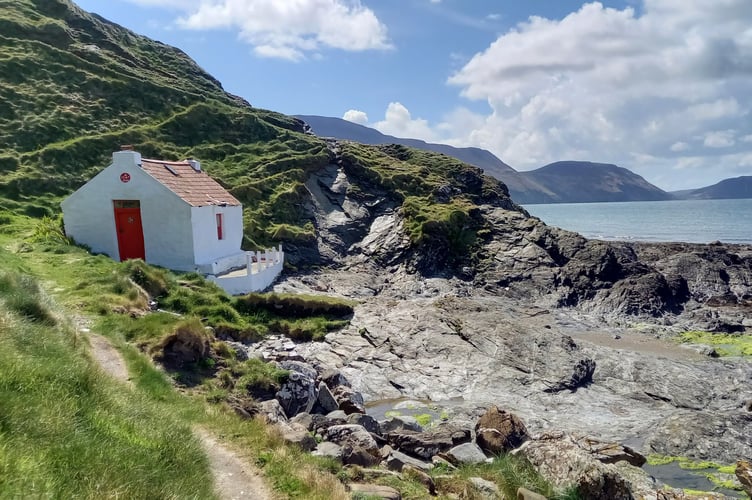A UK national newspaper says railways on the isle of Man puts ‘British train journeys to shame’.
The island has featured in a couple of travel articles in the last few of weeks with visits from James Liston, from the Telegraph and Sarah Baxter from the Guardian.
The Telegraph article focuses on the island’s heritage rail and tram service with Mr Liston taking the steam train to Port Erin on his first day.
He said: ‘Train journeys in mainland Britain are put to shame by the Isle of Man’s heritage railways.
‘It’s 10am and, right on schedule, my train pulls out of Port Erin station, announcing its departure with a cheerful blast of the whistle. Clouds of smoke billow past the window as we gather pace, adding to the magic of the scenery outside: all meadows, hedgerows and patches of woodland bright with purple foxgloves.
‘It’s a landscape that can hardly have changed in the century and a half since trains first huffed and puffed their way through the Manx countryside.’
He explains the history of the steam railway and how the Port Erin route is the only one to survive.
He said: ‘Along with electric trains and horse-drawn trams, these heritage services constitute a huge part of the Isle of Man’s visitor appeal. Their sense of romance perfectly chimes with the step-back-in-time appeal of a place that moves to a gentler rhythm than the UK.
He later takes the electric tram to visit Laxey and the Lady Isabella and then on to Snaefell’s summit where Manannan’s Cloak descends.
The next day he cycles along the old Douglas to Peel railway line before he embarks on a walk along part of Raad ny Foillan at Port Erin.

He also fits in a bit of kayaking near the Calf of Man with Andy North where Mr Liston has a magical experience with inquisitive seals.
He said: ‘Looking down through the clear-bottomed kayak, I can see one underneath me, blowing silvery bubbles through his (the seal’s) nose and then trying to catch them in his teeth as, trapped against the craft, they move around like liquid mercury. And all the while, seals still on the rocks seem to sing in response to Andy’s flute.’
Meanwhile, Ms Baxter tackled a couple of the recently created summit walks to encourage people to explore the island’s central uplands.
She said: ‘I’d taken the ferry from Liverpool to the island to see if I, woman, could master Man in three days, car-free.
On her first day, Ms Baxter walked with Kate Bergquist, an Isle of Man walking ambassador and the founder of Soul Adventures, along the north east summits five peaks challenge.
‘We were following an empty, undulating ridge, bound for pointy North Barrule – at 565 metres the island’s second-highest peak,’ she said. ‘Along the way we chatted about all sorts, from the reinstating of Manx-language place names on maps to the Moddey Dhoo, a black dog said to haunt the land.
‘We ate Manx bonnag, the most delicious spiced soda bread. And we gazed over everything: the flat northern plains, the ravine-nicked south, the navy chop of the Irish Sea, the distant Lake District.’
One her second day, Ms Baxter tackled part of the 10-mile central east summits route, but the weather wasn’t really on her side.
‘I stepped out into a dispiriting pea souper,’ she said. ‘Wondering at the wisdom of my decision, I headed off across a trackless moor, disappearing to the knees in wet tussock.’

She had to cut the walk short and managed to make her way to the mountain railway and back to Laxey.
The next day she headed to Niarbyl for to try out part of the 12-mile south-west summits.
‘This route was magnificent,’ Ms Baxter said. ‘First, I headed north, on road, then through sweet-scented gorse and bracken. Where the mouth of Glen Maye met the beach, I followed the valley inland; leafy, burbly, slender and sinuous, with a secretive waterfall crashing at its end, it was even more fairytale than Ballaglass.’
After climbing to the top of South Barrule and Cronk ny Arrey Laa Ms Baxter went south to Port Erin.
‘Finally the 19th-century crenellations of Milner’s Tower heralded Port Erin Bay,’ she said. ‘A mile or so more and I was on the town’s curve of soft sand, swigging a cold beer from the beach bar. I surveyed the damage: scratched limbs, hair wind-wild, odour questionable. But alive – and buzzing.’

.jpg?width=209&height=140&crop=209:145,smart&quality=75)


